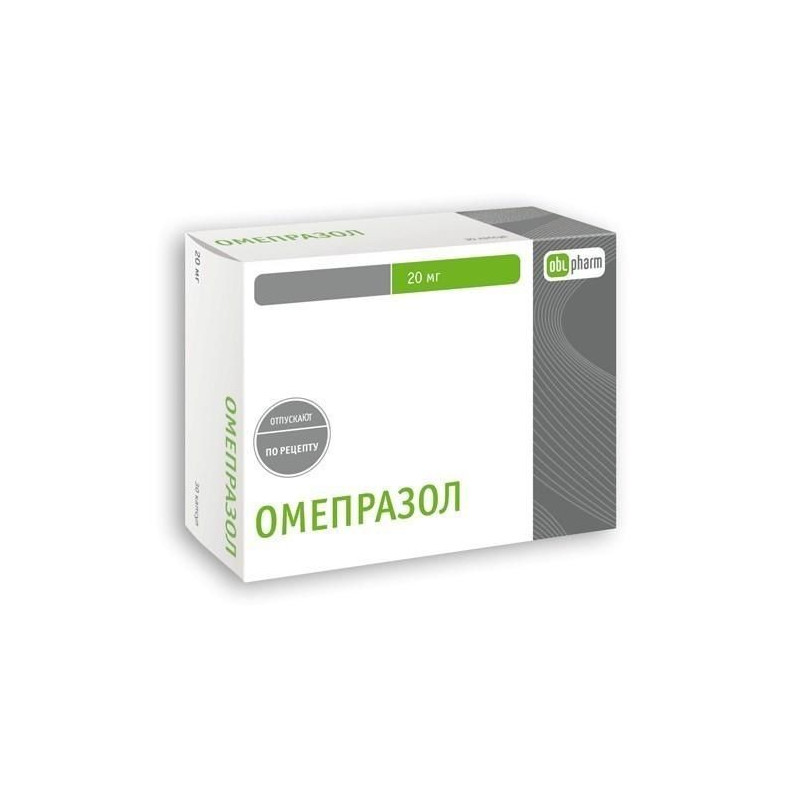



 All payments are encrypted via SSL
All payments are encrypted via SSL
 Full Refund if you haven't received your order
Full Refund if you haven't received your order
Capsules: 1 capsule contains Omeprazole 20 mg;
7 or 10 pieces in a blister, 1, 2, 3, 4 blisters in a carton box.
Anti-ulcer drug. H inhibitor+-K+-ATP-ase ("proton pump"). Inhibits the activity of H+-K+-ATP-ase in the parietal cells of the stomach and, thereby, blocks the final stage of the synthesis of hydrochloric acid. This leads to a decrease in basal and stimulated secretion, regardless of the stimulus.
When administered orally at a dose of 20 mg / day, Omeprazole rapidly and effectively reduces gastric secretion. The maximum effect is achieved during the first 4 days of treatment. In patients with duodenal ulcer, the acidity of gastric juice during 24 hours is constantly reduced by about 80%. When this is achieved, a decrease in the maximum secretion of hydrochloric acid after stimulation with pentagastrin is on average 70% 24 hours after administration.
- gastric ulcer and duodenal ulcer;
- duodenal ulcer associated with Helicobacter pylori (as part of complex therapy);
- reflux esophagitis;
- prevention of severe reflux esophagitis;
- Zollinger-Ellison syndrome.
Hypersensitivity to the drug.
With duodenal ulcer The recommended dose is 20 mg (1 capsule.) 1 time / day. Reduction of symptoms of the disease occurs quickly and in most patients, complete scarring of the ulcer occurs during the first 2 weeks of treatment. Patients who have not fully scarred ulcers after a two-week course, treatment should continue for another 2 weeks.
In case of peptic ulcer of the duodenum resistant to therapy, the drug is prescribed 40 mg 1 time / day; ulcer scarring usually occurs within 4 weeks.
With gastric ulcer The recommended dose is 20 mg 1 time / day. Reduction of symptoms of the disease occurs quickly and in most patients, complete scarring of the ulcer occurs during the first 4 weeks of treatment. Patients who have not fully scarred ulcers after a four-week course, it is necessary to extend the treatment for another 4 weeks.
In case of gastric ulcer resistant to therapy, the drug is prescribed 40 mg 1 time / day; ulcer scarring usually occurs within 8 weeks.
With duodenal ulcer associated with Helicobacter pylori, for the eradication of N. pylori, the drug is prescribed in a dose of 20 mg 2 times / day (morning and evening) for 7 days in combination with antibacterial agents.
With an established duodenal ulcer, drug treatment is continued for another 3 weeks at a dose of 20 mg 1 time / day.
When reflux esophagitis The recommended dose is 20 mg 1 time / day. A reduction in the severity of symptoms of the disease occurs quickly and in most patients a full recovery occurs during the first 4 weeks of therapy, and in a smaller number of patients after 8 weeks. Patients with severe reflux esophagitis prescribe the drug at a dose of 40 mg 1 time / day for 8 weeks.
Musculoskeletal system: in some cases - arthralgia, muscle weakness, myalgia.
Nervous system: headache; rarely - weakness, slight dizziness, paresthesia, drowsiness, insomnia.
Gastrointestinal: diarrhea, constipation, abdominal pain, nausea, vomiting, flatulence; in some cases, stomatitis, gastrointestinal candidiasis, increased liver enzyme activity (with or without increased bilirubin levels).
On the part of the endocrine system: in some cases - gynecomastia.
Hemic and lymphatic: in some cases - leukopenia, thrombocytopenia.
Allergic reactions: seldom - skin rash, hives and / or itching.
Other: in some cases, peripheral edema, visual impairment, change in taste.
Omeprazole is usually well tolerated.
The use of omeprazole during pregnancy is not recommended, except in cases where the intended benefits to the mother outweigh the potential risk to the fetus.
If necessary, the use of omeprazole during lactation should decide on the termination of breastfeeding.
Before starting treatment with omeprazole, the possibility of the presence of a malignant process should be excluded, since drug treatment may mask the symptoms and complicate diagnosis.
The drug should be used with caution in patients with impaired liver function.
In this category of patients, there is an increase in the half-life of omeprazole, so they need to reduce the dose of the drug.
Patients with impaired renal excretory function and elderly patients do not need correction dosing regimen.
When prescribing the drug to patients with diabetes mellitus, it should be borne in mind that each capsule of the drug contains approximately 119 mg of sucrose.
Use in pediatrics
Due to the lack of experience in clinical use, Omeprazole is not recommended for use in children.
Symptoms: blurred vision, drowsiness, agitation, flushing, headache, increased sweating, dry mouth, nausea, tachycardia.
Treatment: conduct symptomatic and supportive therapy. There is no specific antidote.
With the simultaneous use of omeprazole and drugs that are metabolized in the liver with the participation of cytochrome P450 (diazepam, Warfarin, phenytoin) slows down their excretion from the body (if necessary, the simultaneous use of these drugs may require a reduction in their dose).
With simultaneous use of omeprazole and propranolol, Metoprolol, theophylline, Lidocaine, quinidine, Amoxicillin, no clinically significant drug interaction was observed (which, however, can be expected when using omeprazole with drugs metabolized in the liver using the cytochrome P enzyme system450).
With the simultaneous use of omeprazole with antacid drugs interaction is not marked.
With the simultaneous use of omeprazole and NSAIDs drug interaction was not observed.
The drug should be stored in a dry, dark place at room temperature. Keep out of the reach of children.
Omeprazole